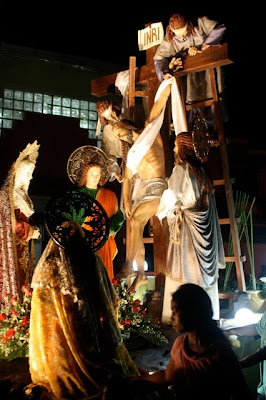Good Friday, among the days of Holy Week, was my favorite. Palm Sunday's palaspas-waving mass was always fun, but I was always dissatisfied with the crowd's uninspired "Free Barabbas!" in the gospel-turned-dialogue. Holy Wednesday's penitensya/senakulo was amusing, but the (literally) pedestrian quality of the production always failed to impress me. Maundy Thursday and Black Saturday just plain sucked because nothing played on our then-non-cable TV. And Easter Sunday always disappointed because I never found the golden Easter Egg in our village's Easter Egg hunting.
Good Friday was my favorite because at dusk, my family would troop over to my dad's hometown of Marikina to witness the yearly spectacle that is prusisyon (procession). And last Friday, after a hiatus due in part to "religious differences," I lassoed my family into renewing the tradition.
Some things never change. San Pedro and his cock still headed the pack and woebegone Maria Soledad, with the face of a babydoll, was still the dramatic finale. Between them, there was still the crocodile under Santa Marta's feet, the artificial tulips in Maria Salome's plexiglass podium, and the elephantine features of the holy corpse of Christ. But this year I counted a whopping 57 floats--a goliath leap from the 38 I diligently catalogued when I was nine. Along with the usual suspects now marched oddly-selected fillers like San Nicodemo and San Longines. (Why a Pharisee and a Roman Centurion would share equal billing with the Virgin and the Apostles is beyond me.)
I always wondered what was so bewitching about Good Friday procession. Perhaps it was the carroza itself: each float's life-sized tableau breathed life into my religion teacher's every Gospel story. Perhaps also it was the theatricality: I found it ingenious that Maria Magdalena's tears were sculpted on to her flawless cheeks, and that smoke effects and thunderclap booming on megaphones accompanied the Pagkamatay ni Kristo sa Krus float. Maybe it was also the spectacle itself--of having scores of debotos lighting a candle and walking miles in the name of their favorite padrino.
Now, a quarter of a century into this lifetime, I think I have reduced the procession's charm to one thing: pageantry. I loved the pageantry of it all--costumes embroidered with gold thread and intricate patterns, oversized copper halos, impeccably scultpted nose bridges, bright orbs of light and enough flowers to rival Baguio's Panagbenga. Having lost my religion was no impediment to enjoying the procession like I did when I was a devout student of our so-called story of salvation. Perhaps because at the heart of it all, prusisyon--fueling a microeconomy of artisans, candle vendors and flower producers--is as much a secular event as it was a religious commemoration. As much profane as it is sacred.
But while standing in the mist of candlelight waiting for the perfect picture to grace my viewfinder, I thought to myself, What if it were all true? Wouldn't it be so much more picture perfect?
Alas, this year was for the mere spectator with his amateur photography.









